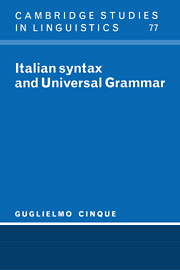Book contents
- Frontmatter
- Contents
- Introduction
- 1 On extraction from NP in Italian
- 2 On the theory of relative clauses and markedness
- 3 Bare quantifiers, quantified NPs, and the notion of operator at S-structure
- 4 On si constructions and the theory of arb
- 5 Ci si
- 6 On a difference between English and Italian “Complement Object Deletion” constructions
- 7 Ergative adjectives and the Lexicalist Hypothesis
- 8 The pseudo-relative and ACC-ing constructions after verbs of perception
- 9 On leftward movement of tutto in Italian
- 10 On the evidence for partial N-movement in the Romance DP
- References
- Index
7 - Ergative adjectives and the Lexicalist Hypothesis
Published online by Cambridge University Press: 01 October 2009
- Frontmatter
- Contents
- Introduction
- 1 On extraction from NP in Italian
- 2 On the theory of relative clauses and markedness
- 3 Bare quantifiers, quantified NPs, and the notion of operator at S-structure
- 4 On si constructions and the theory of arb
- 5 Ci si
- 6 On a difference between English and Italian “Complement Object Deletion” constructions
- 7 Ergative adjectives and the Lexicalist Hypothesis
- 8 The pseudo-relative and ACC-ing constructions after verbs of perception
- 9 On leftward movement of tutto in Italian
- 10 On the evidence for partial N-movement in the Romance DP
- References
- Index
Summary
Introduction
The theory of grammar predicts that a class of ergative adjectives should exist alongside the established classes of ergative verbs (Perlmutter 1978a, b; Burzio 1981, 1986), and ergative nouns. Their existence is a consequence of the X-bar Theory of phrase structure within the more general Lexicalist Hypothesis of Chomsky (1970). X-bar Theory imposes the condition that all phrasal categories (VP, NP, AP, PP, QP, AdvP, IP, CP) have the same internal structure. And the Lexicalist Hypothesis demands that morphologically related verbs, nouns, and adjectives be represented in the lexicon as single, categorially unspecified, entries endowed with certain unique theta-marking and selectional properties.
One would thus expect that an adjective morphologically related to an ergative verb (e.g. morto “dead” related to morire “die”) would also be ergative, that is, it should have its subject generated in object position, under A′, just as the subject of the corresponding ergative verb is generated in the structural object position, under V′.
On the basis of various phenomena in Italian, I will argue that the ergative/unergative distinction does indeed extend to (superficially intransitive) adjectives, in spite of the fact that adjectives which are morphologically related to ergative (and passive) verbs are not themselves ergative. Indeed, one of the reasons why the existence of a class of ergative adjectives was not immediately recognized, and is occasionally even explicitly denied (Burzio 1986; Levin and Rappaport 1986; Stowell 1987) is the absence of this “predicted” class of ergative adjectives.
- Type
- Chapter
- Information
- Italian Syntax and Universal Grammar , pp. 207 - 243Publisher: Cambridge University PressPrint publication year: 1996



